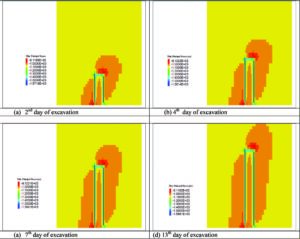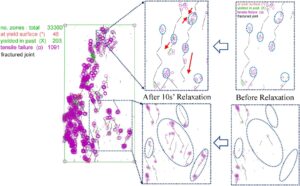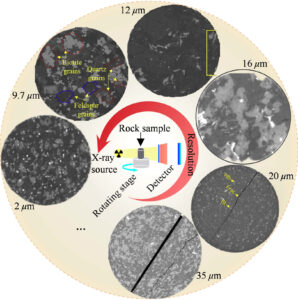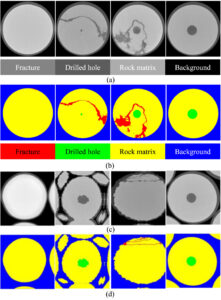Time Dependent Modeling of coal mine entry
We conducted a rock mechanics investigation of the time-dependent behavior of the rock immediately surrounding the excavation in a hypothetical one-entry coal mine based on the geology of

the Illinois coalfields. Research in the area of time-dependency is almost nonexistent and, therefore, this research was performed to make inroads into this neglected research area. Numerical analysis
of a typical one-entry coal mine in an Illinois basin was performed using the commercial finite difference program FLAC3D. The immediate roof of the coal entry was assumed to be a shale formation. Shale in other formations has shown a tendency to creep with time. Therefore, in this study the authors modeled the shale in the roof using time-dependent characteristics. The input properties were taken from laboratory creep tests performed on shale. Model runs were performed at different stages, mimicking the progressive excavation of the entry. The model results showed that stresses in the roof attained the limit of yielding. Using Mohr-Coulomb failure criteria, potential zones of failure were also predicted. The results showed that the current computational capacities are sufficient to explore this previously uncharted territory of ground control.
Numerical Simulation of the Relaxation Behavior of Failed Sandstone Specimens
The relaxation test on sandstone specimens showed typical behavior in pre-failure region and stepwise behavior in the post-failure region. Overall, more significant stress relaxation occurred

within the failed specimens than the intact ones. Numerical simulations were conducted with pre-defined failure plane and with Voronoi tessellation to visualize the relaxation behavior. The model with pre-defined failure plane showed the key role of failure plane and asperity in simulating the step-wise post-failure relaxation behavior. The inhomogeneous stress distribution within failed specimen and the viscous deformation of intact rocks induced high stress concentration at the asperities. The observed step-wise relaxation initiated from the failure of asperity. Furthermore, the simulations with Voronoi tessellation showed time-dependent fracture development during relaxation in post-failure region. The presence of fractures completely changed the stress distribution. Stress concentration occurred at the front area of fractures and at the interacting areas between fractures. During relaxation, fractures still developed with time and the sudden significant increase in the “damage” coincided with the acceleration of stress relaxation leading to step-wise relaxation. Finally, the results showed the possibility of using residual strength as the long-term strength of failed rock.
Mapping distribution of fractures and minerals in rock samples using Res-VGG-UNet and threshold segmentation methods
Understanding the internal structures of rock and their subsequent evolution is essential across multiple disciplines. Fractures and mineral grains are significant components of internal structures. These components influence natural processes and human activities, such as oil migration and extraction. With advancements in non-destructive evaluation (NDE) techniques, especially X-ray computed tomography (CT), in-depth analyses of internal structures of rock have become feasible. However, the data-intensive nature of CT scans necessitates more efficient post-processing algorithms. This research uses the Residual Network-Visual Geometry Group-UNet (Res-VGG-UNet) deep learning framework in conjunction with two threshold segmentation methods to capture components like fractures, the drilled hole, and minerals. The performance of Res-VGG-UNet is evaluated against DeepLabv3+ and Weka3D. Key findings include the capability of the deep learning technique to distinguish between various components and the performance of single-slice-based versus multi-slice-based threshold segmentation methods. VGG16 and VGG19 outperform DeepLabv3+ and Weka3D in the performance of fracture classification. Moreover, a 3D reconstruction technique is introduced, providing enhanced insights into internal features of the rock. We conclude this paper by showing the potential to use the outcomes of the deep learning and multi-slice-based threshold segmentation methods to develop discrete element models, accurately reflecting the physical characteristics of rock specimens.



